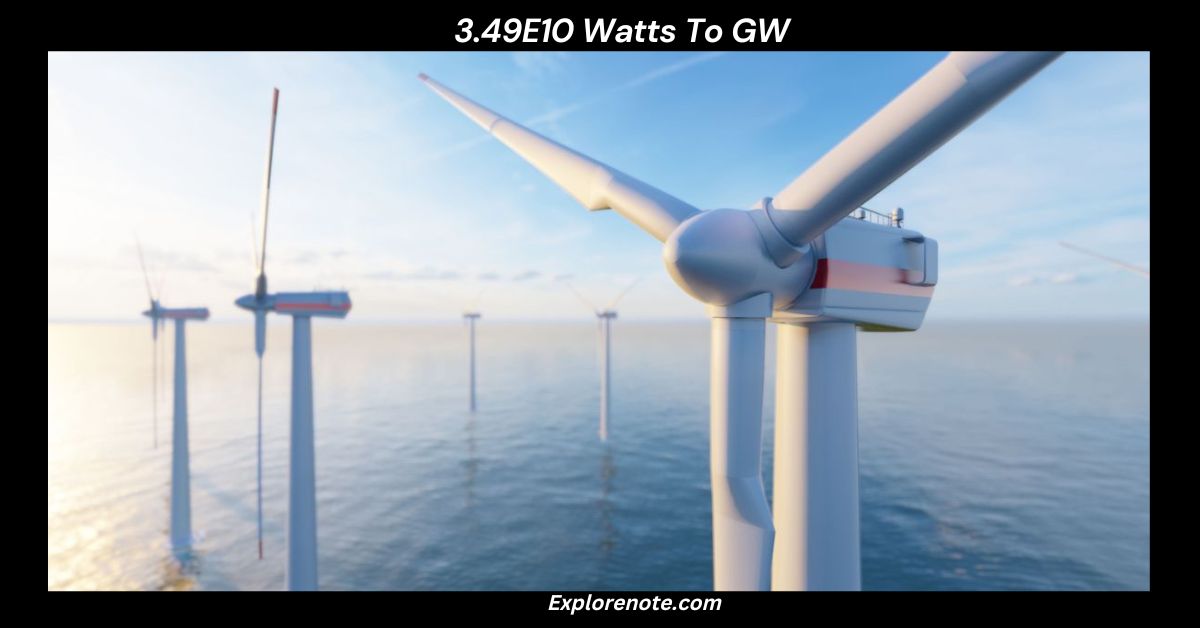Electric power measurements often come with large numbers and scientific notations, which can seem intimidating at first.
One such example is converting “3.49E10 Watts to GW.” If you’re searching for clarity on this conversion and how it relates to practical scenarios, this guide will break it all down in an easy-to-understand way.
What is 3.49E10 Watts to GW?
“3.49E10 Watts to GW” represents a conversion from watts, a standard unit of power, to gigawatts, which is used for larger-scale energy measurements.
By dividing 3.49E10 watts by one billion, we find that 3.49E10 watts equals 34.9 gigawatts (GW).
This measurement is significant in the context of global energy discussions, industrial power needs, and large-scale energy production projects.
What Does 3.49E10 Watts Mean?
The notation 3.49E10 is a shorthand for scientific notation, where the number 3.49 is multiplied by 10 to the power of 10. Written out in standard numerical form, it looks like this:
3.49E10 = 34,900,000,000 Watts
That’s 34.9 billion watts of power—a significant amount, often seen in the context of large-scale energy production, industrial usage, or scientific applications.
What Are Gigawatts (GW)?
Gigawatts (GW) represent a unit of power in the metric system. It is equivalent to one billion (1,000,000,000) watts.
Gigawatts are commonly used when discussing power generation from large facilities, such as nuclear plants, hydroelectric dams, or wind farms.
To put this into perspective:
1 GW can power roughly 750,000 homes in the U.S. (depending on average energy consumption).
The largest nuclear power plant in the U.S., Palo Verde in Arizona, has a capacity of about 3.9 GW.
Converting 3.49E10 Watts to Gigawatts
To convert watts to gigawatts, you simply divide the number of watts by 1 billion (1,000,000,000). Let’s calculate:
3.49E10 ÷ 1,000,000,000 = 34.9 GW
So, 3.49E10 watts is equal to 34.9 gigawatts. This conversion is straightforward once you understand the relationship between watts and gigawatts.
Practical Implications of 34.9 GW
The value 34.9 GW represents an immense amount of energy. Here are some real-world contexts where such power might be relevant:
Power Plants:
A single coal-fired power plant typically produces around 500 MW (0.5 GW). It would take approximately 70 such plants to produce 34.9 GW.
Large-scale hydroelectric dams, like the Grand Coulee Dam in Washington, have a capacity of about 6.8 GW, meaning nearly six of these would be needed to match 34.9 GW.
Renewable Energy:
The global shift to renewable energy has seen massive wind and solar farms contributing gigawatts to the grid. For example, offshore wind farms like Dogger Bank in the UK aim to generate 3.6 GW.
A 34.9 GW wind farm would require thousands of turbines, each rated at 5 MW or higher.
National Grids:
In 2023, the average electricity consumption of the entire United States hovered around 4,000 TWh annually.
To sustain such demand, the national grid needs consistent contributions from multiple sources. A 34.9 GW facility could significantly support peak loads.
How to Use This Conversion in Everyday Scenarios
Whether you’re a student, engineer, or just curious, knowing how to convert “3.49E10 Watts to GW” can help in several ways:
Understanding Appliance Energy Ratings:
While gigawatts represent large-scale power, understanding their conversion can help you grasp how much energy is consumed or generated by smaller units.
For example, a household solar panel generating 300 watts contributes a minuscule fraction of a gigawatt.
Interpreting Energy News:
When news outlets discuss large energy projects or goals, such as building wind farms or increasing renewable energy capacity by 50 GW, you can better visualize what these figures mean in practical terms.
Academic Studies:
Students and professionals in physics, engineering, and environmental sciences frequently encounter such conversions in coursework, research, and projects.
Energy Efficiency Conversations:
Understanding power scales like 3.49E10 watts versus gigawatts can make discussions about energy efficiency and carbon footprints more relatable.
For instance, replacing incandescent bulbs with LED lights reduces energy consumption, even if only a small part of the overall grid’s gigawatt load.
Policy and Investment Decisions:
If you’re considering investments in energy companies or have an interest in energy policy, knowing how to interpret large power figures is essential.
Why Is It Important to Understand Large-Scale Energy Measurements?
As the world becomes more reliant on energy to sustain modern lifestyles, understanding large-scale energy measurements like gigawatts is crucial for several reasons:
Energy Awareness:
Knowing how much energy is consumed or produced on a large scale fosters a better understanding of the global energy landscape.
It helps individuals recognize the importance of energy efficiency and conservation efforts.
Climate Change and Sustainability:
Large-scale energy production often correlates with environmental impact. Understanding measurements like 34.9 GW can highlight the scale of renewable energy projects and their potential to reduce carbon emissions.
Technological Advancements:
Innovations in energy storage, grid management, and renewable technologies often focus on gigawatt-scale solutions. Grasping these measurements helps contextualize breakthroughs in energy science.
Policy and Decision Making:
Policymakers use large-scale energy data to make informed decisions about infrastructure investments, energy imports, and renewable energy targets.
Economic Implications:
Energy production and consumption are directly tied to economic activity. Understanding large-scale measurements enables better insights into economic growth, industrial capabilities, and energy markets.
Educational and Career Growth:
For students and professionals, understanding energy measurements opens doors to careers in engineering, environmental science, energy consulting, and more.
FAQs about 3.49E10 Watts to GW
What is the exact value of 3.49E10 Watts in Gigawatts?
The exact value is 34.9 GW. This is obtained by dividing 3.49E10 watts by 1 billion.
Why do we use gigawatts instead of watts?
Gigawatts are used to simplify discussions involving large-scale power. It’s easier to say “34.9 GW” than “34,900,000,000 watts.”
What is an example of something that uses gigawatts of power?
Large-scale power plants or entire regions’ energy consumption can be measured in gigawatts. For instance, the U.S. energy grid operates at several hundred gigawatts at any given time.
How many watts are in a gigawatt?
One gigawatt equals 1,000,000,000 watts (1 billion watts).
How does 34.9 GW compare to global energy needs?
While 34.9 GW is a significant amount of power, the global energy demand is much higher. For perspective, the worldwide electricity generation capacity exceeds 7,000 GW.
Can 34.9 GW power an entire country?
It depends on the country. For instance, small nations with lower energy consumption might require less than 34.9 GW to sustain their needs, while larger nations like the U.S. need much more.
Conclusion
Understanding how to convert “3.49E10 Watts to GW” isn’t just about math; it’s about grasping the scale of energy in today’s world.
With 34.9 GW, you’re looking at a power output capable of supporting millions of households or several industrial facilities.
Whether you’re studying, working in the energy sector, or simply curious, mastering these concepts opens the door to deeper insights into the energy that powers our lives.










